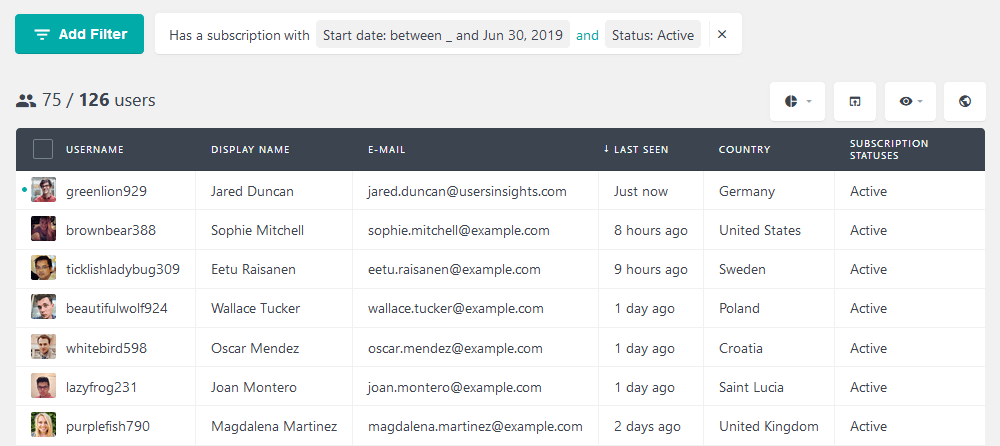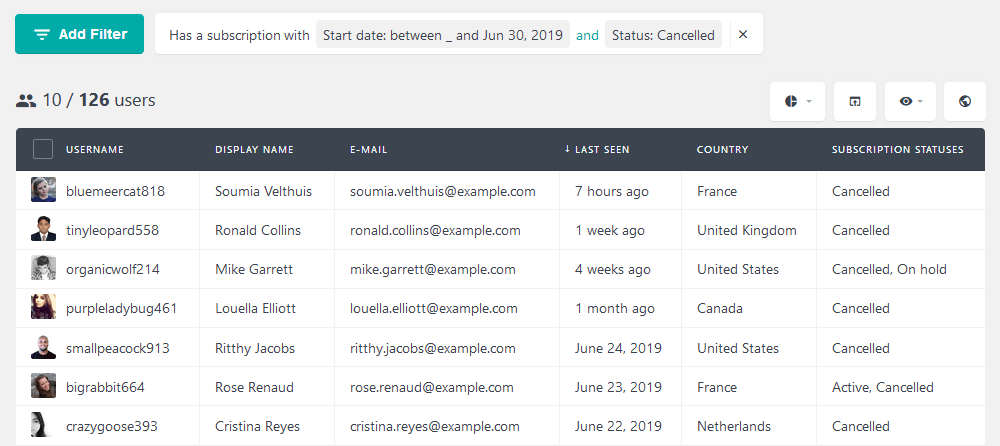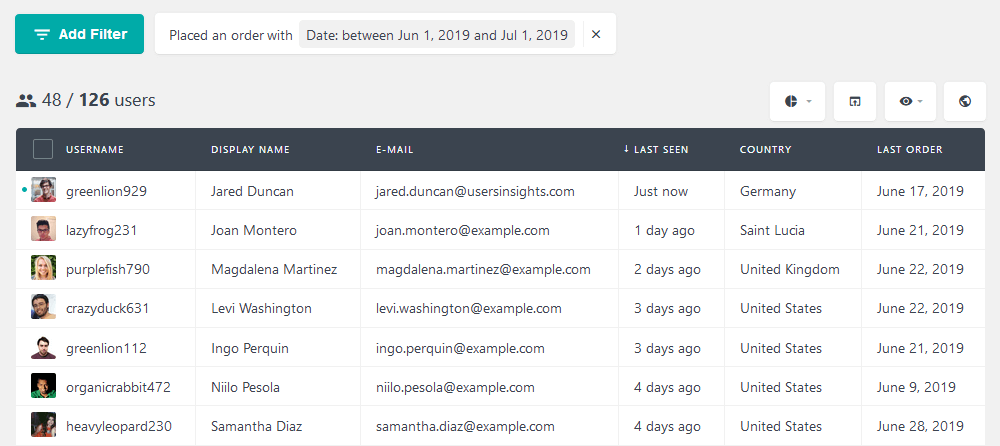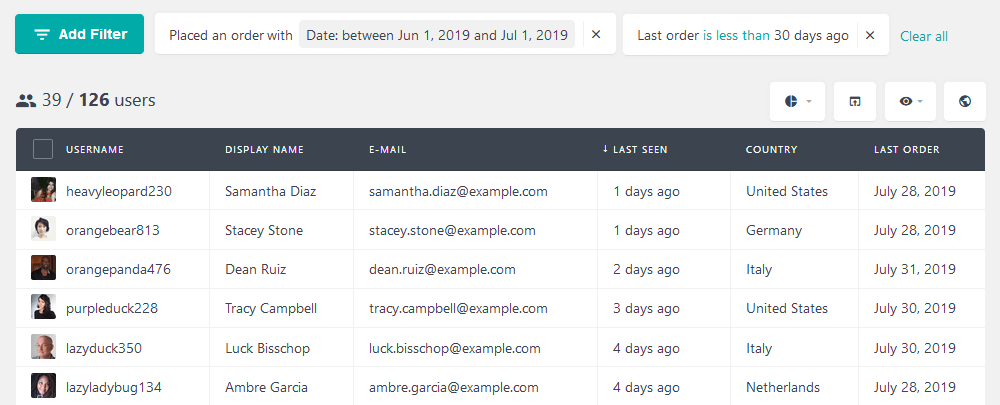Customer churn explained
On the path to a great online business you need to evaluate a lot of metrics. Quite often you may face yourself with questions regarding future customer base size or even cash flow projections. But you can only predict the future when you know the current state of things. Surely, you can simply look at your customer base growth rate, but is that enough?
Usually the growth rates compare the size of your customer base in one date, then its size in another date. But this rate doesn’t tell the whole story. This growth comes from new users, but the cancellations are invisible when using this metric. That’s when the customer churn comes to play.
With the customer churn rates, we identify how many users left within a specific timeframe. Thus, we compare cancellations in a timeframe with the customer base size in the beginning of that period. This gives you precious information about the customer satisfaction and repeat purchases.
With the customer churn rates, we identify how many users left within a specific timeframe.
But there are many aspects within the churn rate to consider. For example, your business type may affect on how to calculate your formulas. In addition, you may find critical rates for churn peaks as you compare different timeframes. Let’s discuss this in detail in this article.

Churn rate meaning, definition and scope
Let’s expand on the churn rate meaning now. The main goal of the churn rate is to define how many customers you lost during a timeframe. This is important, because simple growth metrics may hide any cancellations during a period.
For example, let’s say you had 100 customers. Then a month later you have 110. This looks good, right? Well, your customer base grew 10% so everything is fine. But when you look at cancellations within that period, you notice that you lost 10 customers. This means that you have a 10% churn rate for that month.
But look at the implications of this figure. Out of these 110 customers, 20 are new, and 90 are old. In order words, if you had a better customer retention, your growth could be even twice as big. And when we look into the costs of acquiring new customers then low churn rates are even more seductive. That’s because the cost of customer retention is usually negligible when compared to the customer acquisition costs.
The cost of customer retention is usually negligible when compared to the customer acquisition costs.
It is crucial to define what is an active customer for you. Usually subscription-based business models have an edge on this factor. You simply count an active customer based on their active subscriptions. But even that may be too simplistic.
Say you have a 6-month subscription minimum, and a customer hasn’t visited your site in 5 months. What are the odds that this customer is really “active”? Chances are, this customer will not renew their subscription when it’s due.
When it comes to products and services with no subscription, usually the buying cycle is important. If you know that a customer needs to buy coffee once a month, you can plan accordingly. Thus customers who haven’t placed a new order after the billing cycle has passed can be considered inactive.
The churn rate meaning is quite flexible and can be applied even to blogs. For that, the customer churn definition falls into how long a visitor takes between visits. That is your buying cycle, and what can be used for your customer churn predictions.
Another important aspect of your customer churn analysis are critical values. This is an important aspect that is often forgotten about the dynamics of your customer churn rate. Remember, we define arbitrary periods for our customer churn rates. Therefore, this gives us the ability to manipulate these times and find which customer churn periods are important for you.
Back to our example, you had 100 customers. Then after 30 days you lost 10. Now let’s look a bit further and a bit closer. You may discover that after 15 days you lost 2 customers, but after 60 days you lost 12. This means that your churn rates are:
- 15 days = 2%
- 30 days = 10%
- 60 days = 12%
Notice how after 30 days the churn rate has de-accelerated – it should be 20% for a proportional reduction. In addition, look at how it spiked from 2% to 10%. This means that you need to keep a close eye on your customer relationship for these 15-30 days periods. That’s when you are losing most of your customers.
One last aspect of the churn rate is that it can be measured as revenue percentage. This is relevant in markets where you have different prices and multiple products. Adjusting for the price helps you focus on customer segments that bring more revenue.
Churn rate formula
The churn rate formula is quite simple. As we mentioned, usually you simply calculate it as:
CUSTOMERS LOST IN PERIOD / CUSTOMERS AT THE BEGINNING OF THE PERIOD
As the period in itself is arbitrary, you can set any timeframe you want. Longer timeframes will generate bigger churn rates. You can ease this effect if you want to compare churn rates in different timeframes. A simple way would be simply to divide your churn by the period size
CHURN / PERIOD SIZE
This gives your churn in days (or weeks, or months). This allows you to compare different churn rates for 30 days, 60 days and so on. In our previous example, we would have these calculations for the daily churn rate formula:
- 15 days = 0.13 (churn/day)
- 30 days = 0.33 (churn/day)
- 60 days = 0.20 (churn / day)
This clearly shows what we saw before, that our critical period is between 15 and 60 days. This is when our daily churn is at its highest.
Another interesting application for the churn rate formula is when we weight for revenue lost. For example, if we have 50 customers for subscription A and 50 for subscription B. Then after 30 days we have 48 for A and 42 for B. The general formula for the revenue churn rate is:
( ( PRICE A * CUSTOMERS LOST FOR A ) + ( PRICE B * CUSTOMERS LOST FOR B) ) / INITIAL REVENUE
If A costs $1 and B costs $10, then this is our churn:
( (1 * 2) + (10 * 8) ) / ( 50 * 1 + 50 * 10) = ( 2 + 80 ) / ( 50 + 500 ) = 82 / 550 = 14.9%
You can see that even though the number of customers we lost is the same, the revenue lost is bigger. That’s because we lost more high-paying customers.
WooCommerce customer churn
It’s time to get our hands dirty! Let’s discover your own customer churn rates, based on what we learned so far.
We use the Users Insights plugin, as it is a quick way to filter through your registered users. We are looking for WooCommerce customer churn rates for subscription and regular products.
First, your customer churn rate for a subscription product. We will calculate that for the past month. The easiest way to do that is to find how many customers we have active by that date. Then we find the inactive. Here is an example:

Next we find the cancelled subscriptions:

This shows that we have 75 active and 10 inactive. Therefore, our churn is 10/ (75+10) = 11.75%
As we mentioned, you can use the buying cycle to find inactive customers as well. For this example, let’s find the churn for a product with a buying cycle of 30 days. Therefore, we find how many customers were active 30-60 days ago and how many of them are active now. This gives us our churn.
Thus, for the active customer base 30-60 days ago:

And the active customer base now just for these who had orders 30-60 days ago:

Now we have all the ingredients to find our churn sate for a product-based store. That’s (48 – 39) / 48 = 18.75%.
You could add other modifiers to your filters, such as specific products, countries, job titles. These are ways to break your churn rates further and find out which customer segment or products have high churn.
How to reduce customer churn
In general, if you want to reduce customer churn, you need to have a better customer relationship. Thus, reducing churn rates is actually a consequence of better customer relationship management.
The most basic element is to find out why your customers cancel their contracts. Usually, cancelation reasons can be inferred from your communication with them or their activity logs. Therefore, you need to show that you are ready to fix these problems before then become a real issue.
Here, your critical customer churn rate is key. Once you know when the cancellations happen, you can act accordingly.
You can expand your communication channels as well. Having appropriate channels for new ideas, beta testing, support and others helps responding to customers. Quite often you can find great gems coming from your customers, as they may have new uses for your products. Thus, this is valuable not just to create a stronger bond, but to improve future development as well.
Conclusion
Today we looked into what is customer churn. Beyond the basic definition, we saw how to apply this to different business types. Thus, we went through customer churn rate meaning, definition and forms. In addition, we investigated the churn rate formula. Then we saw how to apply these techniques and find your WooCommerce customer churn. Lastly, we expanded on relationship marketing and how to reduce customer churn.
We hope you enjoyed this article and see you again next time!
